NEWS NEW ENGLAND WEAVERS SEMINAR Smith College, Northhampton, MA
 INKLE LOOM WEAVING (1 Day)
INKLE LOOM WEAVING (1 Day)
No weaving experience necessary! The inkle loom is portable, easy to warp, easy to weave off, and makes beautiful belts and bands. Daryl uses it to trim her garments. Every weaver should own one. They are inexpensive and children as young as third grade can learn to use them. Schacht type Inkle Looms or Ashford Inklette Inkle Looms and yarn will be provided.
Starting with a PowerPoint presentation, participants will learn to make heddles for the loom, follow a draft and warp the inkle loom. Proper techniques for weaving a tight even band with good selvedges will be explained. A more intermediate technique of Inkle Loom Pick-up for interesting design options will also be demonstrated. Participants will be able to finish a small project by the end of the day. Materials Fee
 PHOTOGRAPHING YOUR WORK: A CRITIQUE OF PARTICIPANT’S IMAGES
PHOTOGRAPHING YOUR WORK: A CRITIQUE OF PARTICIPANT’S IMAGES
Often handweavers are rejected from exhibits because of the poor quality of their images. Find out what works and what doesn’t. Even if you use a professional photographer, knowing what jurors are looking for will help improve the quality of your final presentation. Using Power Point, the basics of photography, both film and digital will be discussed, as well as composition and lighting, and basic digital image manipulation using Photoshop Elements 4.0®. Lots of images illustrating what NOT to do! In addition, participants will be asked to send examples of their images in film or digital format ahead of the workshop, for critique.
Through a series of creative exercises, participants will learn to confidently place yarns of different colors and textures together to make beautiful warp combination’s. This is a fun, hands-on class, and participants will be asked to bring a bag of assorted odds and ends of yarns to work with and to share with others. In addition, participants will learn to create palettes using Color-aid blocks and photographs. Based on the Color/Fabric Forecast Column from Handwoven Magazine, participants will experiment with palettes based on mood using photos for inspiration and see illustrations of how to translate them into handwoven fabrics and ultimately a garment.
 A SEWER’S PERSPECTIVE: INSTRUCTIONAL TOUR OF THE JURIED FASHION SHOW
A SEWER’S PERSPECTIVE: INSTRUCTIONAL TOUR OF THE JURIED FASHION SHOW
An interactive exploration behind the “seams” of the garments from the Fashion Show. You saw them on the runway, now see them up close and inside. Participants will experience a technical critique of garments on display, seeing the inside finishing techniques as well as the outside appearance, and fit. This kind of experience provides the participants with many ideas for finishing, what works and what doesn’t. A terrific “behind the seams” look allowing participants to view first hand, some of the choices used by experienced fiber artists.
 WARP FAST: LEARN TO WARP MORE THAN ONE THREAD AT A TIME
WARP FAST: LEARN TO WARP MORE THAN ONE THREAD AT A TIME
Through a series of slides, students will learn about the fast method of sectional warping. Explore the advantages and disadvantages of this production technique. The AVL warping wheel will also be discussed. In addition, use of the inexpensive rigid heddle
warping paddle will be demonstrated. This device allows the weaver to chain warp up to 24 ends at a time. Calculating warps for repeats will also be covered if time permits.
Contact: www.newenglandweaversseminar.com



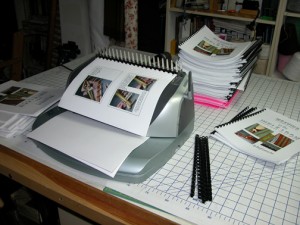 I haven’t been on the road for awhile, so I am sort of not in the traveling mind set. I leave for the
I haven’t been on the road for awhile, so I am sort of not in the traveling mind set. I leave for the 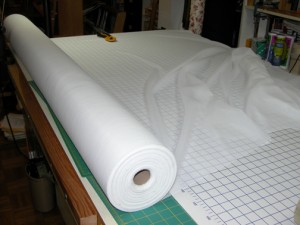 Once I bound the huge stack of handouts (I printed 18 books each for the
Once I bound the huge stack of handouts (I printed 18 books each for the 

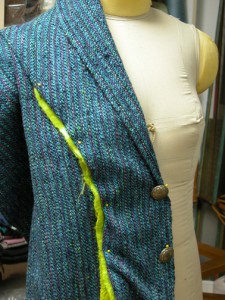
 OK, so I sat through the movie, which was excellent, we went to see Doubt, beautifully shot, great angles and juxtapositions through the camera lens that really added dimension to the story, but I was really thinking about whether I wanted to put the lime green felt edge piping around the collar/front edge, or in the princess seams. So I played around in Photoshop, using the rubber stamp tool, with a photo of the muslin, and a separate photo of a close up of the fabric. It really gave me an idea of the jacket in the fabric, which I really like, and then I could take a green “pencil”, and sort of simulate the “piping”. I’m thinking that around the collar and down the front, looks sort of expected, but in the princess seams, there is a real slimming line that occurs, and accents the body shape. I think it will look especially graphic in the back. So I’m posting the photos, and will mull this over while I sleep, and revisit it tomorrow.
OK, so I sat through the movie, which was excellent, we went to see Doubt, beautifully shot, great angles and juxtapositions through the camera lens that really added dimension to the story, but I was really thinking about whether I wanted to put the lime green felt edge piping around the collar/front edge, or in the princess seams. So I played around in Photoshop, using the rubber stamp tool, with a photo of the muslin, and a separate photo of a close up of the fabric. It really gave me an idea of the jacket in the fabric, which I really like, and then I could take a green “pencil”, and sort of simulate the “piping”. I’m thinking that around the collar and down the front, looks sort of expected, but in the princess seams, there is a real slimming line that occurs, and accents the body shape. I think it will look especially graphic in the back. So I’m posting the photos, and will mull this over while I sleep, and revisit it tomorrow.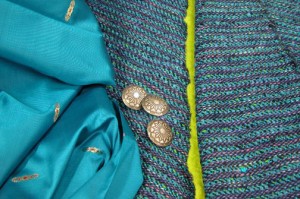
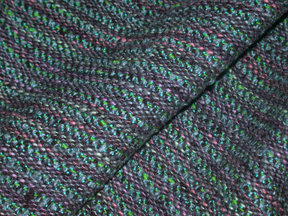
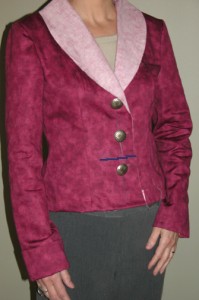 So when last we left off, I was tracing the Burda pattern onto the tracing medium, and then of course, the next step is a muslin. I know this doesn’t look like a muslin, but I use whatever junk is on my shelf, I have this huge hunk of decorator fabric which someone gave me, which in the picture is actually appealing, but trust me, it isn’t. So instead of wasting perfectly good muslin, I made up the jacket in this. The upper collar/facing was left out, you get the general idea without going to all that trouble, and I put the cuff on only one sleeve. The sleeves are too long, I always have to shorten Burda sleeves, an easy fix, and the jacket itself, although cute, and well fitting, is way too short waisted. By about 2 inches (see blue line in photo). The buttons look compressed, and the torso looks squished. The lime green edge of the felt piping would come down the princess seams, or, now that I look at the photo, maybe I could run it down the edge of the collar/front. There will be a welt pocket in the side front, and a belt in the center back.
So when last we left off, I was tracing the Burda pattern onto the tracing medium, and then of course, the next step is a muslin. I know this doesn’t look like a muslin, but I use whatever junk is on my shelf, I have this huge hunk of decorator fabric which someone gave me, which in the picture is actually appealing, but trust me, it isn’t. So instead of wasting perfectly good muslin, I made up the jacket in this. The upper collar/facing was left out, you get the general idea without going to all that trouble, and I put the cuff on only one sleeve. The sleeves are too long, I always have to shorten Burda sleeves, an easy fix, and the jacket itself, although cute, and well fitting, is way too short waisted. By about 2 inches (see blue line in photo). The buttons look compressed, and the torso looks squished. The lime green edge of the felt piping would come down the princess seams, or, now that I look at the photo, maybe I could run it down the edge of the collar/front. There will be a welt pocket in the side front, and a belt in the center back.